Electrical Engineering Project: WiFi Installation for Shopping Centre
VerifiedAdded on 2022/05/12
|10
|1350
|32
Project
AI Summary
This project outlines a comprehensive WiFi installation plan for a shopping centre, detailing the essential considerations, required equipment, and labor. The project begins with an introduction to wireless communication and its significance, followed by a discussion of key factors like throughput, number of nodes, and security. It then details the necessary equipment, including access points (Cisco Aironet), gateways, routers (Microtik), and Meraki software for network monitoring and management. The project includes a cost analysis, breaking down equipment and labor expenses, and presents a Gantt chart outlining the project timeline. The solution uses a hybrid wireless deployment plan, and provides a detailed cost breakdown, concluding with a total estimated cost and references to relevant literature.

WiFI installation 1
SHOPPING CENTRE: WIFI INSTALLATION
Name
Instructor
Institution
Course
City
Date
SHOPPING CENTRE: WIFI INSTALLATION
Name
Instructor
Institution
Course
City
Date
Paraphrase This Document
Need a fresh take? Get an instant paraphrase of this document with our AI Paraphraser
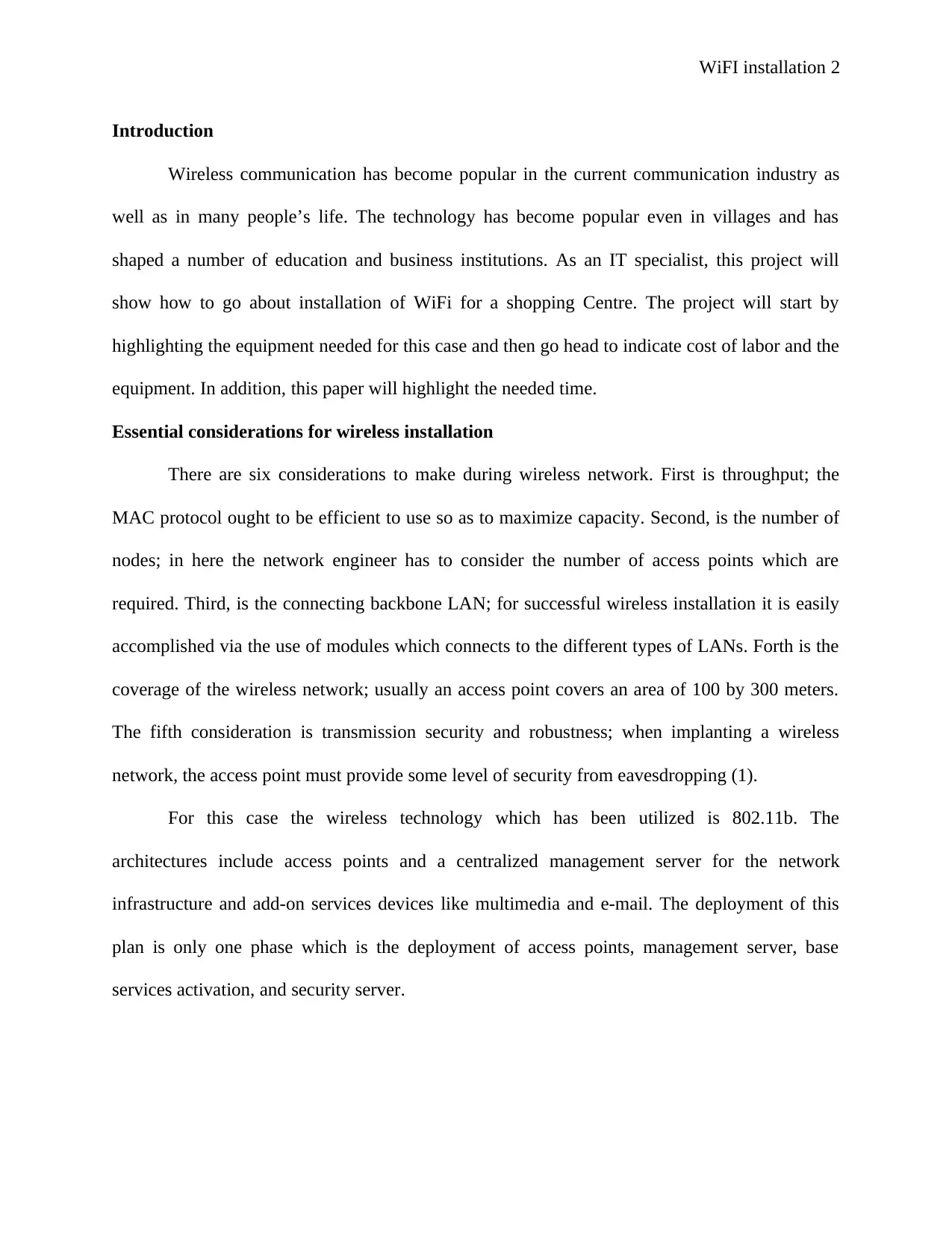
WiFI installation 2
Introduction
Wireless communication has become popular in the current communication industry as
well as in many people’s life. The technology has become popular even in villages and has
shaped a number of education and business institutions. As an IT specialist, this project will
show how to go about installation of WiFi for a shopping Centre. The project will start by
highlighting the equipment needed for this case and then go head to indicate cost of labor and the
equipment. In addition, this paper will highlight the needed time.
Essential considerations for wireless installation
There are six considerations to make during wireless network. First is throughput; the
MAC protocol ought to be efficient to use so as to maximize capacity. Second, is the number of
nodes; in here the network engineer has to consider the number of access points which are
required. Third, is the connecting backbone LAN; for successful wireless installation it is easily
accomplished via the use of modules which connects to the different types of LANs. Forth is the
coverage of the wireless network; usually an access point covers an area of 100 by 300 meters.
The fifth consideration is transmission security and robustness; when implanting a wireless
network, the access point must provide some level of security from eavesdropping (1).
For this case the wireless technology which has been utilized is 802.11b. The
architectures include access points and a centralized management server for the network
infrastructure and add-on services devices like multimedia and e-mail. The deployment of this
plan is only one phase which is the deployment of access points, management server, base
services activation, and security server.
Introduction
Wireless communication has become popular in the current communication industry as
well as in many people’s life. The technology has become popular even in villages and has
shaped a number of education and business institutions. As an IT specialist, this project will
show how to go about installation of WiFi for a shopping Centre. The project will start by
highlighting the equipment needed for this case and then go head to indicate cost of labor and the
equipment. In addition, this paper will highlight the needed time.
Essential considerations for wireless installation
There are six considerations to make during wireless network. First is throughput; the
MAC protocol ought to be efficient to use so as to maximize capacity. Second, is the number of
nodes; in here the network engineer has to consider the number of access points which are
required. Third, is the connecting backbone LAN; for successful wireless installation it is easily
accomplished via the use of modules which connects to the different types of LANs. Forth is the
coverage of the wireless network; usually an access point covers an area of 100 by 300 meters.
The fifth consideration is transmission security and robustness; when implanting a wireless
network, the access point must provide some level of security from eavesdropping (1).
For this case the wireless technology which has been utilized is 802.11b. The
architectures include access points and a centralized management server for the network
infrastructure and add-on services devices like multimedia and e-mail. The deployment of this
plan is only one phase which is the deployment of access points, management server, base
services activation, and security server.
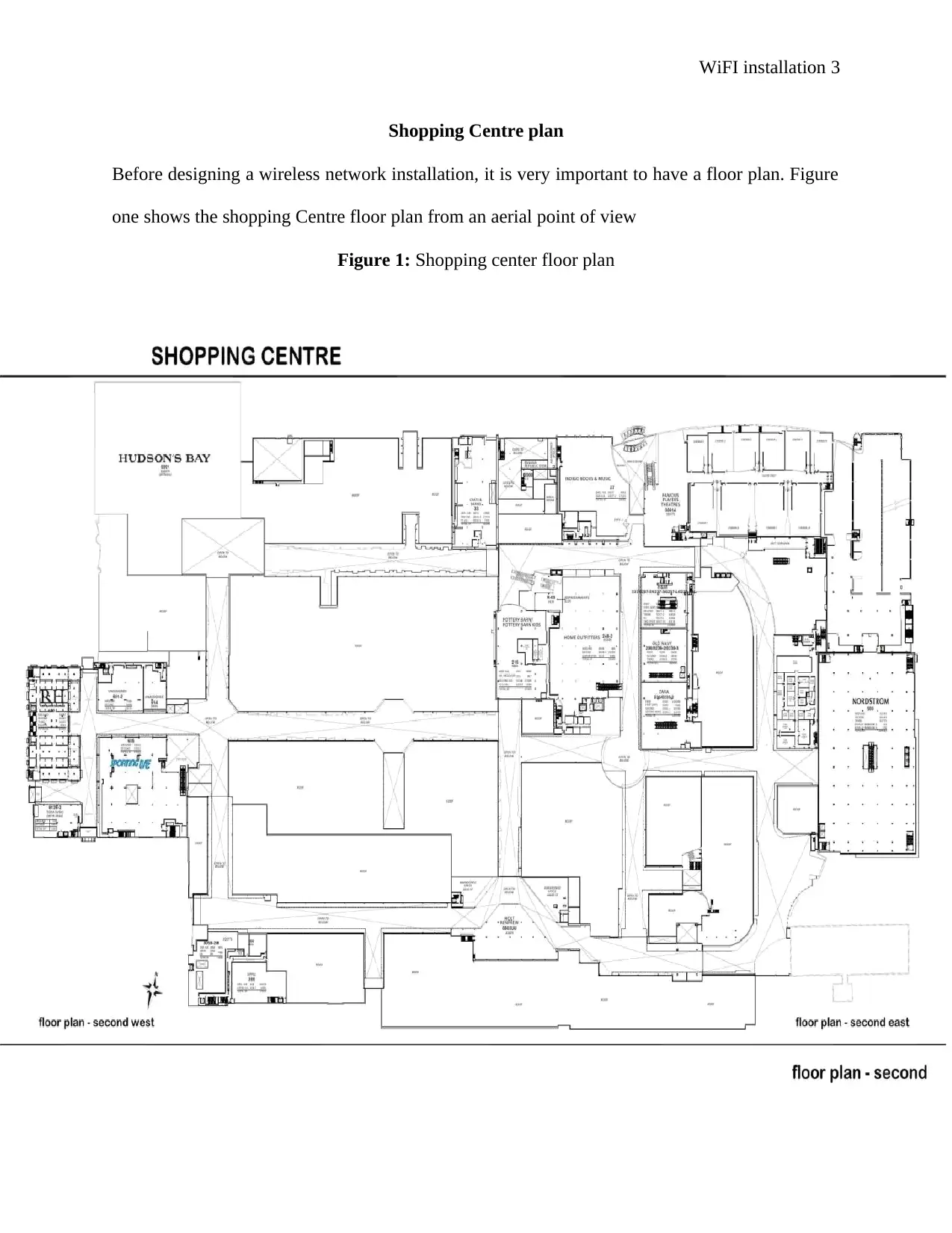
WiFI installation 3
Shopping Centre plan
Before designing a wireless network installation, it is very important to have a floor plan. Figure
one shows the shopping Centre floor plan from an aerial point of view
Figure 1: Shopping center floor plan
Shopping Centre plan
Before designing a wireless network installation, it is very important to have a floor plan. Figure
one shows the shopping Centre floor plan from an aerial point of view
Figure 1: Shopping center floor plan
⊘ This is a preview!⊘
Do you want full access?
Subscribe today to unlock all pages.

Trusted by 1+ million students worldwide
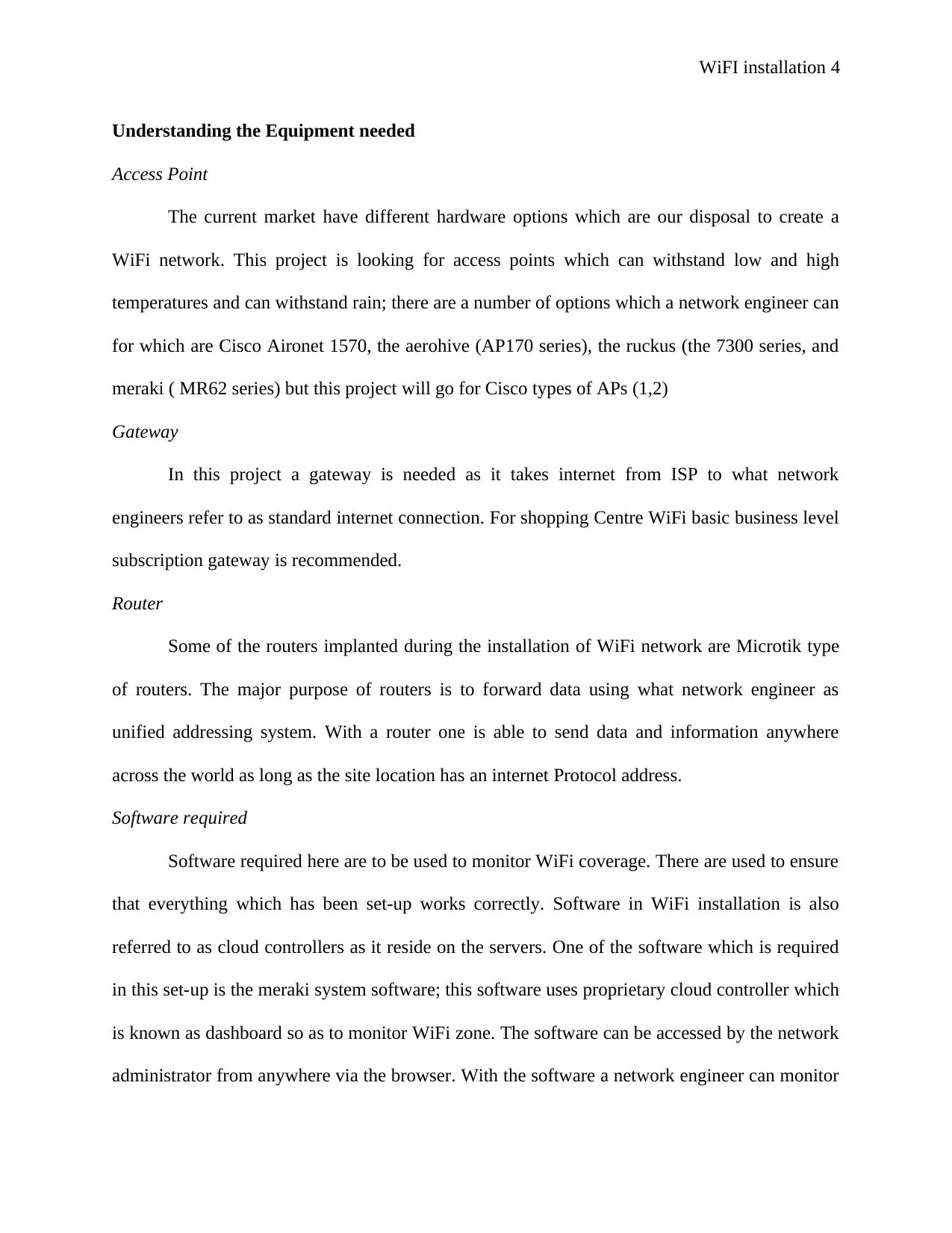
WiFI installation 4
Understanding the Equipment needed
Access Point
The current market have different hardware options which are our disposal to create a
WiFi network. This project is looking for access points which can withstand low and high
temperatures and can withstand rain; there are a number of options which a network engineer can
for which are Cisco Aironet 1570, the aerohive (AP170 series), the ruckus (the 7300 series, and
meraki ( MR62 series) but this project will go for Cisco types of APs (1,2)
Gateway
In this project a gateway is needed as it takes internet from ISP to what network
engineers refer to as standard internet connection. For shopping Centre WiFi basic business level
subscription gateway is recommended.
Router
Some of the routers implanted during the installation of WiFi network are Microtik type
of routers. The major purpose of routers is to forward data using what network engineer as
unified addressing system. With a router one is able to send data and information anywhere
across the world as long as the site location has an internet Protocol address.
Software required
Software required here are to be used to monitor WiFi coverage. There are used to ensure
that everything which has been set-up works correctly. Software in WiFi installation is also
referred to as cloud controllers as it reside on the servers. One of the software which is required
in this set-up is the meraki system software; this software uses proprietary cloud controller which
is known as dashboard so as to monitor WiFi zone. The software can be accessed by the network
administrator from anywhere via the browser. With the software a network engineer can monitor
Understanding the Equipment needed
Access Point
The current market have different hardware options which are our disposal to create a
WiFi network. This project is looking for access points which can withstand low and high
temperatures and can withstand rain; there are a number of options which a network engineer can
for which are Cisco Aironet 1570, the aerohive (AP170 series), the ruckus (the 7300 series, and
meraki ( MR62 series) but this project will go for Cisco types of APs (1,2)
Gateway
In this project a gateway is needed as it takes internet from ISP to what network
engineers refer to as standard internet connection. For shopping Centre WiFi basic business level
subscription gateway is recommended.
Router
Some of the routers implanted during the installation of WiFi network are Microtik type
of routers. The major purpose of routers is to forward data using what network engineer as
unified addressing system. With a router one is able to send data and information anywhere
across the world as long as the site location has an internet Protocol address.
Software required
Software required here are to be used to monitor WiFi coverage. There are used to ensure
that everything which has been set-up works correctly. Software in WiFi installation is also
referred to as cloud controllers as it reside on the servers. One of the software which is required
in this set-up is the meraki system software; this software uses proprietary cloud controller which
is known as dashboard so as to monitor WiFi zone. The software can be accessed by the network
administrator from anywhere via the browser. With the software a network engineer can monitor
Paraphrase This Document
Need a fresh take? Get an instant paraphrase of this document with our AI Paraphraser
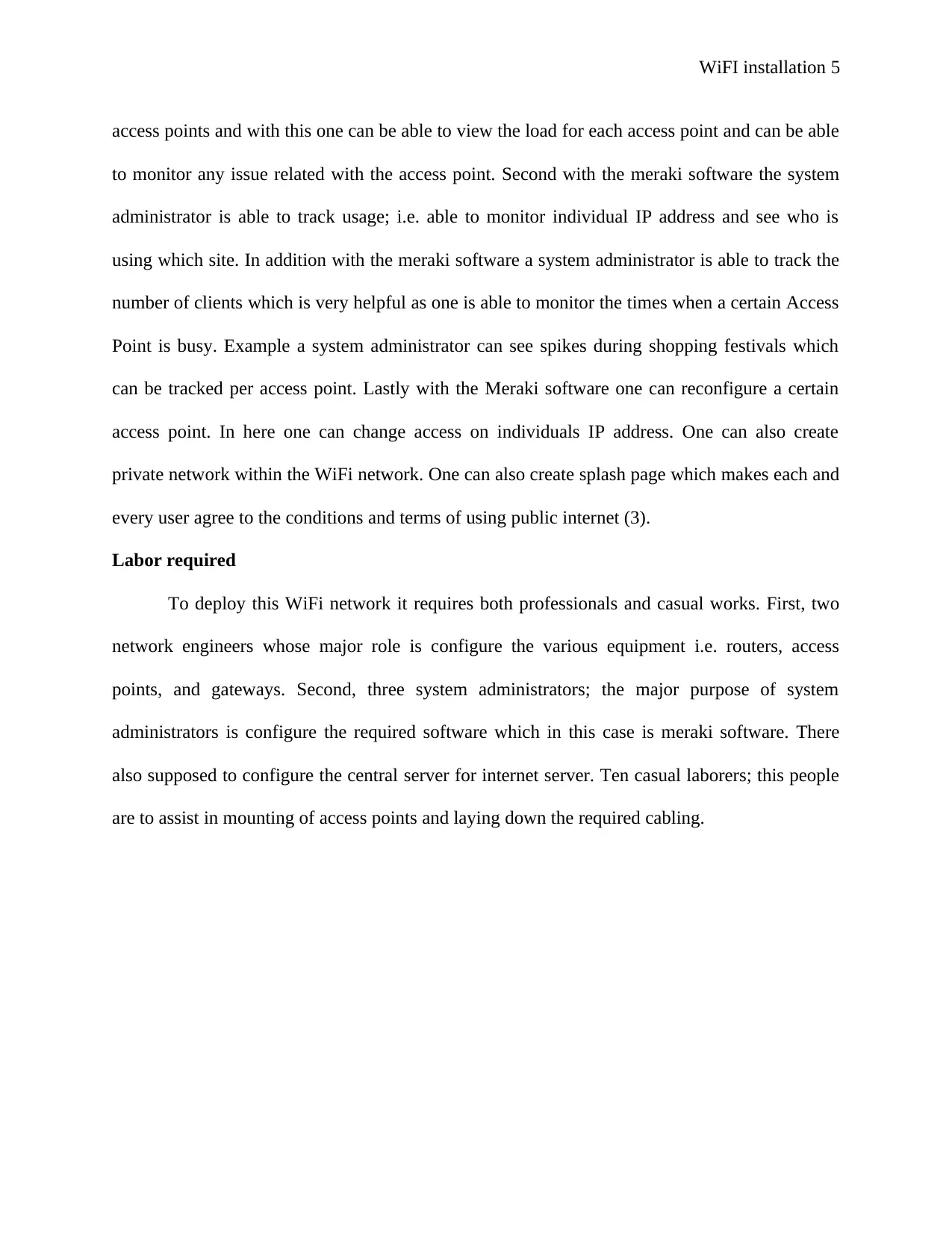
WiFI installation 5
access points and with this one can be able to view the load for each access point and can be able
to monitor any issue related with the access point. Second with the meraki software the system
administrator is able to track usage; i.e. able to monitor individual IP address and see who is
using which site. In addition with the meraki software a system administrator is able to track the
number of clients which is very helpful as one is able to monitor the times when a certain Access
Point is busy. Example a system administrator can see spikes during shopping festivals which
can be tracked per access point. Lastly with the Meraki software one can reconfigure a certain
access point. In here one can change access on individuals IP address. One can also create
private network within the WiFi network. One can also create splash page which makes each and
every user agree to the conditions and terms of using public internet (3).
Labor required
To deploy this WiFi network it requires both professionals and casual works. First, two
network engineers whose major role is configure the various equipment i.e. routers, access
points, and gateways. Second, three system administrators; the major purpose of system
administrators is configure the required software which in this case is meraki software. There
also supposed to configure the central server for internet server. Ten casual laborers; this people
are to assist in mounting of access points and laying down the required cabling.
access points and with this one can be able to view the load for each access point and can be able
to monitor any issue related with the access point. Second with the meraki software the system
administrator is able to track usage; i.e. able to monitor individual IP address and see who is
using which site. In addition with the meraki software a system administrator is able to track the
number of clients which is very helpful as one is able to monitor the times when a certain Access
Point is busy. Example a system administrator can see spikes during shopping festivals which
can be tracked per access point. Lastly with the Meraki software one can reconfigure a certain
access point. In here one can change access on individuals IP address. One can also create
private network within the WiFi network. One can also create splash page which makes each and
every user agree to the conditions and terms of using public internet (3).
Labor required
To deploy this WiFi network it requires both professionals and casual works. First, two
network engineers whose major role is configure the various equipment i.e. routers, access
points, and gateways. Second, three system administrators; the major purpose of system
administrators is configure the required software which in this case is meraki software. There
also supposed to configure the central server for internet server. Ten casual laborers; this people
are to assist in mounting of access points and laying down the required cabling.
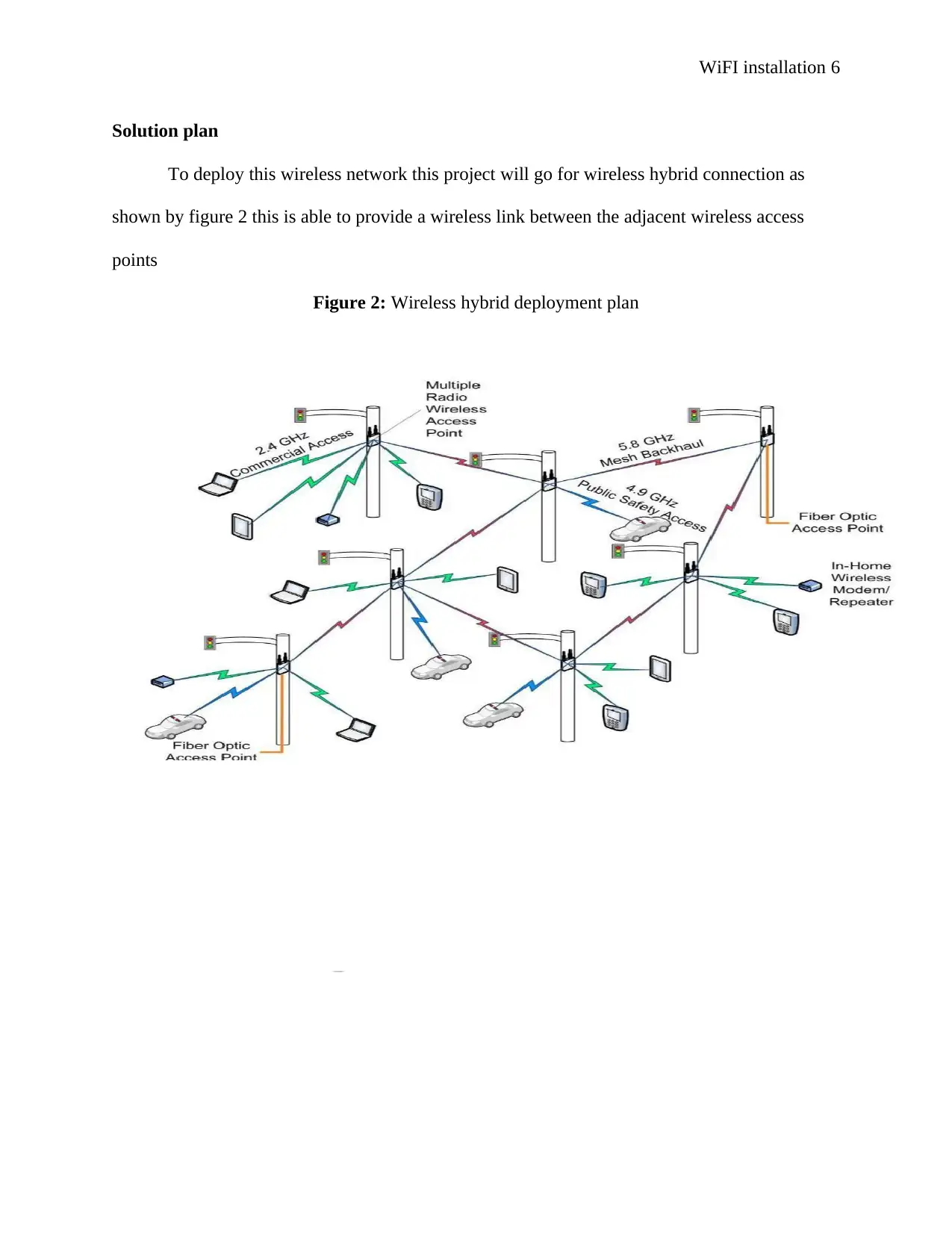
WiFI installation 6
Solution plan
To deploy this wireless network this project will go for wireless hybrid connection as
shown by figure 2 this is able to provide a wireless link between the adjacent wireless access
points
Figure 2: Wireless hybrid deployment plan
Solution plan
To deploy this wireless network this project will go for wireless hybrid connection as
shown by figure 2 this is able to provide a wireless link between the adjacent wireless access
points
Figure 2: Wireless hybrid deployment plan
⊘ This is a preview!⊘
Do you want full access?
Subscribe today to unlock all pages.

Trusted by 1+ million students worldwide
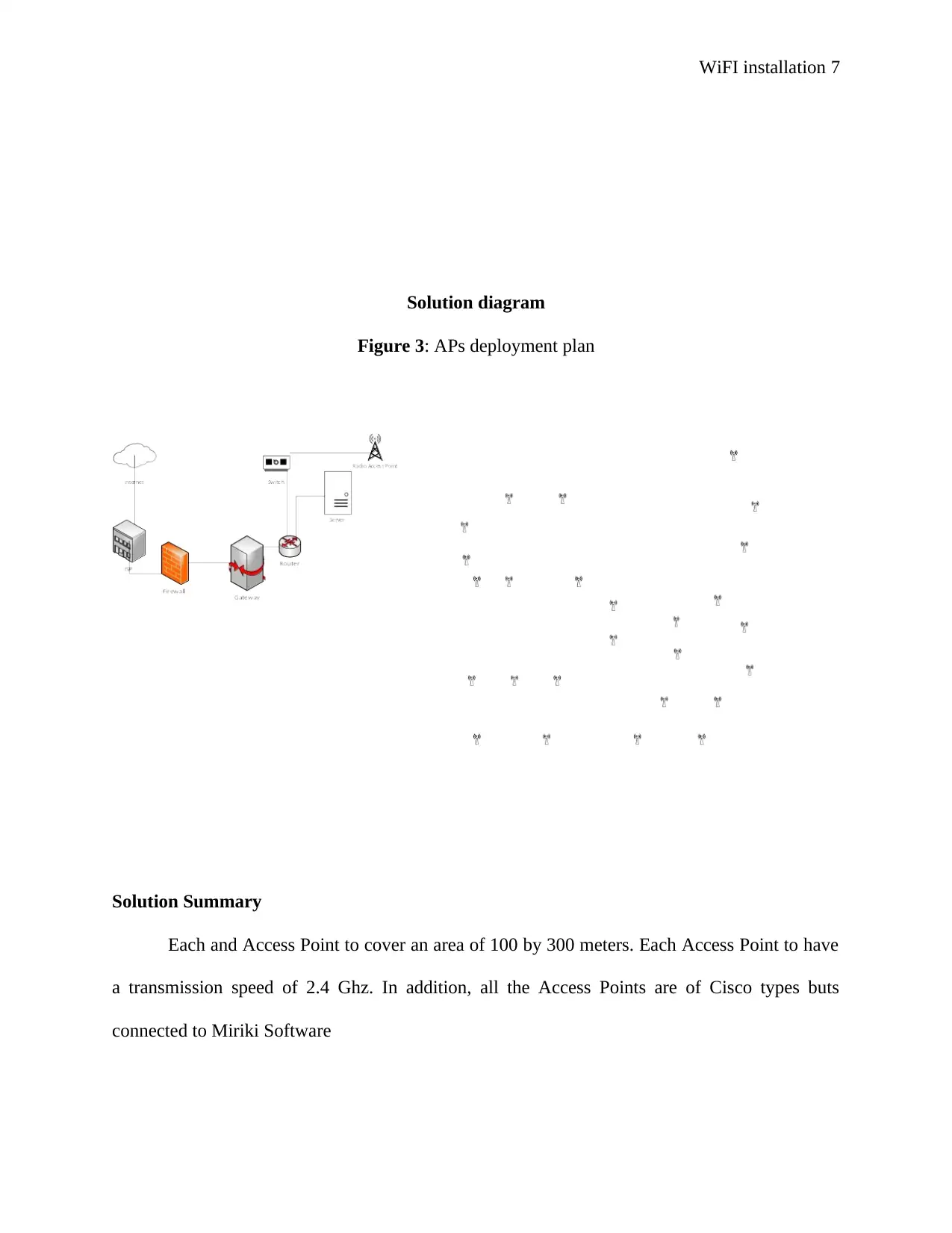
WiFI installation 7
Solution diagram
Figure 3: APs deployment plan
Solution Summary
Each and Access Point to cover an area of 100 by 300 meters. Each Access Point to have
a transmission speed of 2.4 Ghz. In addition, all the Access Points are of Cisco types buts
connected to Miriki Software
Solution diagram
Figure 3: APs deployment plan
Solution Summary
Each and Access Point to cover an area of 100 by 300 meters. Each Access Point to have
a transmission speed of 2.4 Ghz. In addition, all the Access Points are of Cisco types buts
connected to Miriki Software
Paraphrase This Document
Need a fresh take? Get an instant paraphrase of this document with our AI Paraphraser
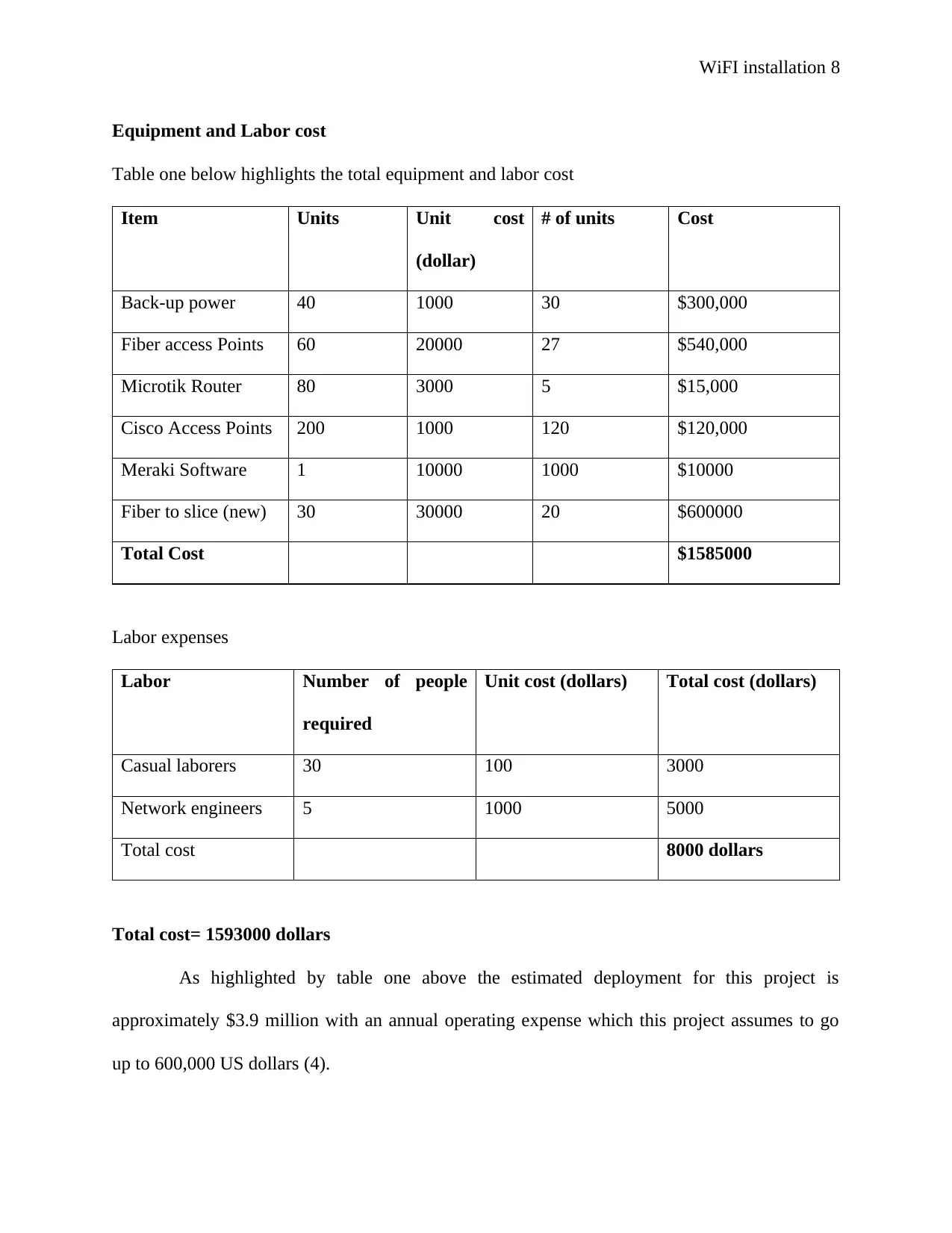
WiFI installation 8
Equipment and Labor cost
Table one below highlights the total equipment and labor cost
Item Units Unit cost
(dollar)
# of units Cost
Back-up power 40 1000 30 $300,000
Fiber access Points 60 20000 27 $540,000
Microtik Router 80 3000 5 $15,000
Cisco Access Points 200 1000 120 $120,000
Meraki Software 1 10000 1000 $10000
Fiber to slice (new) 30 30000 20 $600000
Total Cost $1585000
Labor expenses
Labor Number of people
required
Unit cost (dollars) Total cost (dollars)
Casual laborers 30 100 3000
Network engineers 5 1000 5000
Total cost 8000 dollars
Total cost= 1593000 dollars
As highlighted by table one above the estimated deployment for this project is
approximately $3.9 million with an annual operating expense which this project assumes to go
up to 600,000 US dollars (4).
Equipment and Labor cost
Table one below highlights the total equipment and labor cost
Item Units Unit cost
(dollar)
# of units Cost
Back-up power 40 1000 30 $300,000
Fiber access Points 60 20000 27 $540,000
Microtik Router 80 3000 5 $15,000
Cisco Access Points 200 1000 120 $120,000
Meraki Software 1 10000 1000 $10000
Fiber to slice (new) 30 30000 20 $600000
Total Cost $1585000
Labor expenses
Labor Number of people
required
Unit cost (dollars) Total cost (dollars)
Casual laborers 30 100 3000
Network engineers 5 1000 5000
Total cost 8000 dollars
Total cost= 1593000 dollars
As highlighted by table one above the estimated deployment for this project is
approximately $3.9 million with an annual operating expense which this project assumes to go
up to 600,000 US dollars (4).
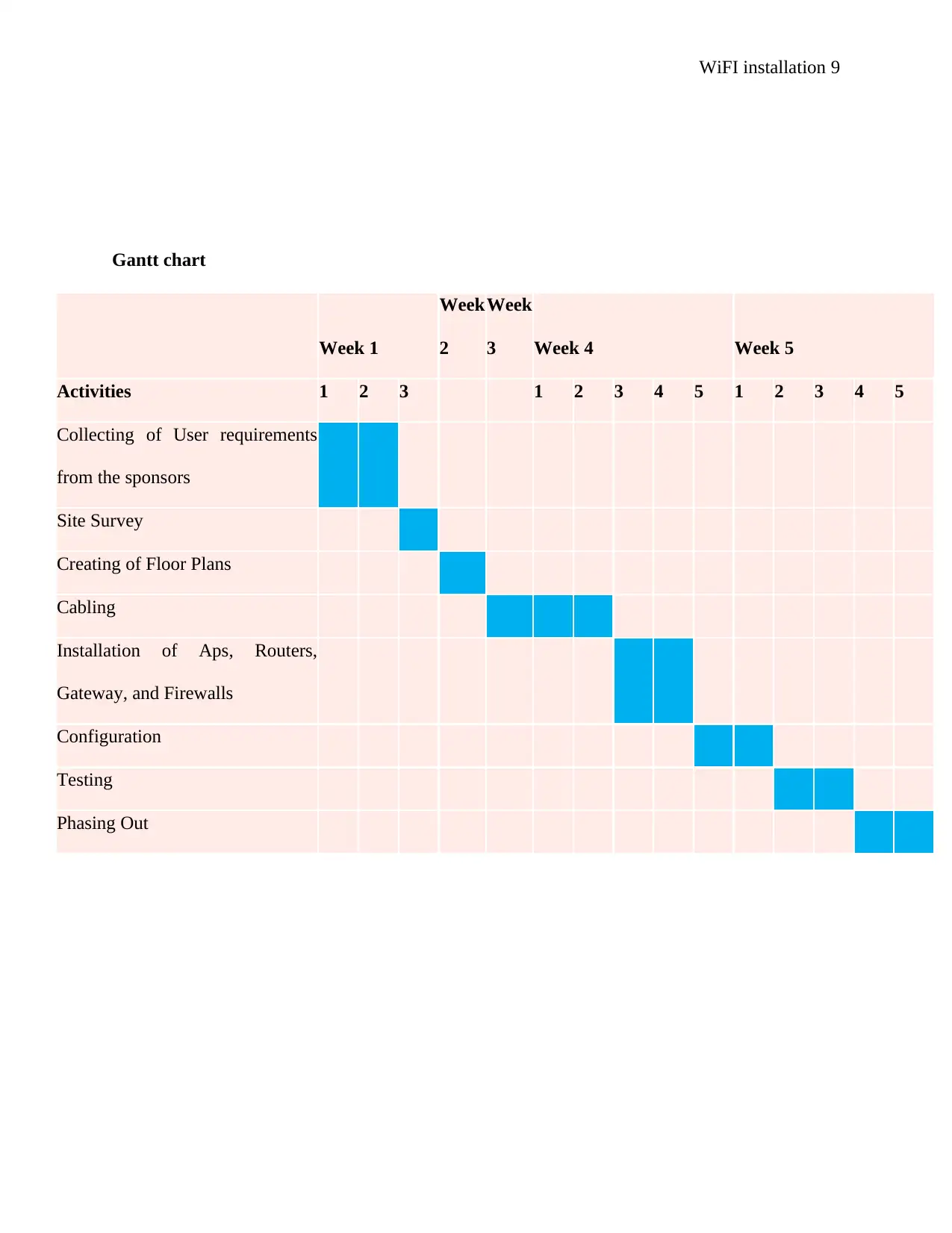
WiFI installation 9
Gantt chart
Week 1
Week
2
Week
3 Week 4 Week 5
Activities 1 2 3 1 2 3 4 5 1 2 3 4 5
Collecting of User requirements
from the sponsors
Site Survey
Creating of Floor Plans
Cabling
Installation of Aps, Routers,
Gateway, and Firewalls
Configuration
Testing
Phasing Out
Gantt chart
Week 1
Week
2
Week
3 Week 4 Week 5
Activities 1 2 3 1 2 3 4 5 1 2 3 4 5
Collecting of User requirements
from the sponsors
Site Survey
Creating of Floor Plans
Cabling
Installation of Aps, Routers,
Gateway, and Firewalls
Configuration
Testing
Phasing Out
⊘ This is a preview!⊘
Do you want full access?
Subscribe today to unlock all pages.

Trusted by 1+ million students worldwide
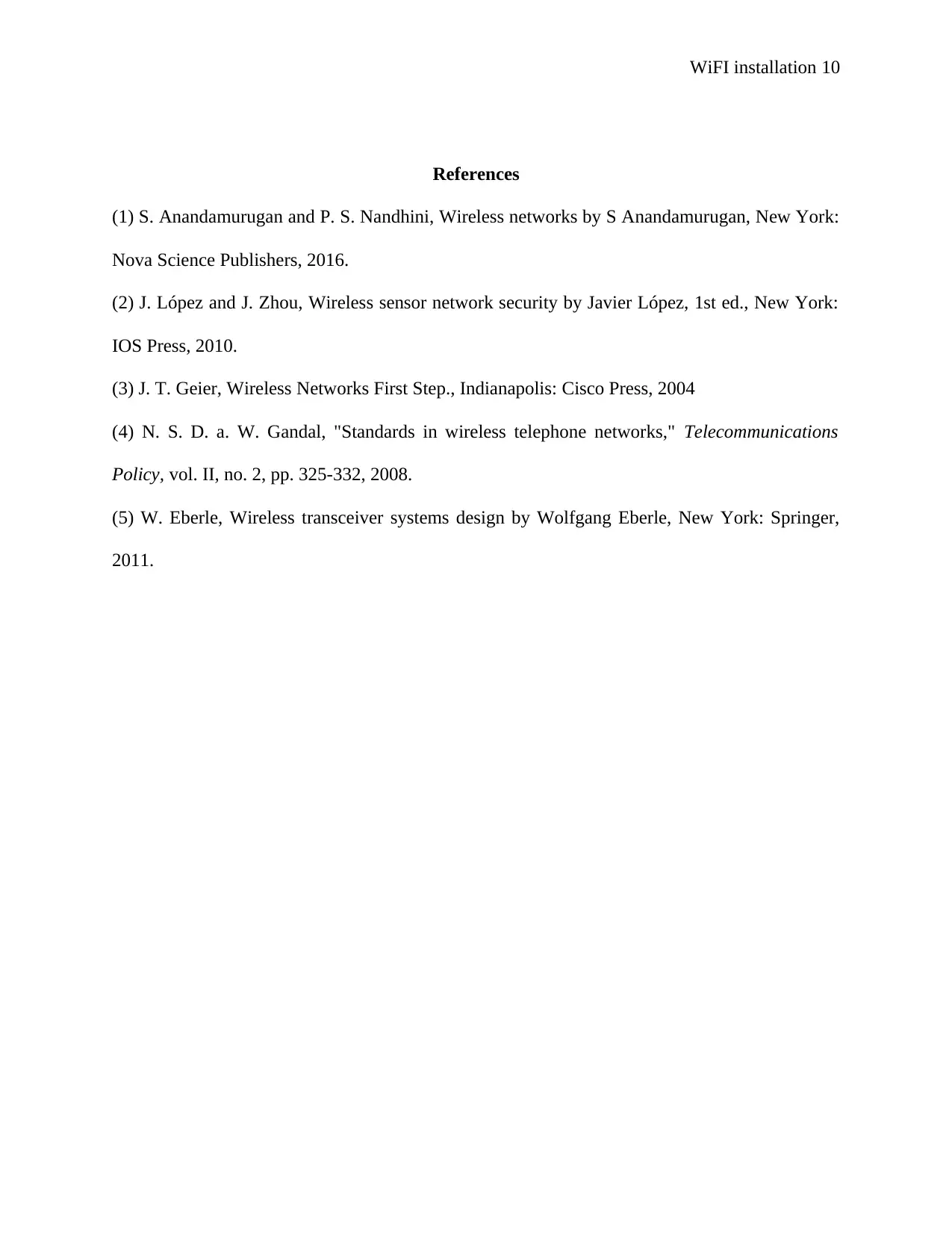
WiFI installation 10
References
(1) S. Anandamurugan and P. S. Nandhini, Wireless networks by S Anandamurugan, New York:
Nova Science Publishers, 2016.
(2) J. López and J. Zhou, Wireless sensor network security by Javier López, 1st ed., New York:
IOS Press, 2010.
(3) J. T. Geier, Wireless Networks First Step., Indianapolis: Cisco Press, 2004
(4) N. S. D. a. W. Gandal, "Standards in wireless telephone networks," Telecommunications
Policy, vol. II, no. 2, pp. 325-332, 2008.
(5) W. Eberle, Wireless transceiver systems design by Wolfgang Eberle, New York: Springer,
2011.
References
(1) S. Anandamurugan and P. S. Nandhini, Wireless networks by S Anandamurugan, New York:
Nova Science Publishers, 2016.
(2) J. López and J. Zhou, Wireless sensor network security by Javier López, 1st ed., New York:
IOS Press, 2010.
(3) J. T. Geier, Wireless Networks First Step., Indianapolis: Cisco Press, 2004
(4) N. S. D. a. W. Gandal, "Standards in wireless telephone networks," Telecommunications
Policy, vol. II, no. 2, pp. 325-332, 2008.
(5) W. Eberle, Wireless transceiver systems design by Wolfgang Eberle, New York: Springer,
2011.
1 out of 10
Related Documents
Your All-in-One AI-Powered Toolkit for Academic Success.
+13062052269
info@desklib.com
Available 24*7 on WhatsApp / Email
![[object Object]](/_next/static/media/star-bottom.7253800d.svg)
Unlock your academic potential
Copyright © 2020–2025 A2Z Services. All Rights Reserved. Developed and managed by ZUCOL.



